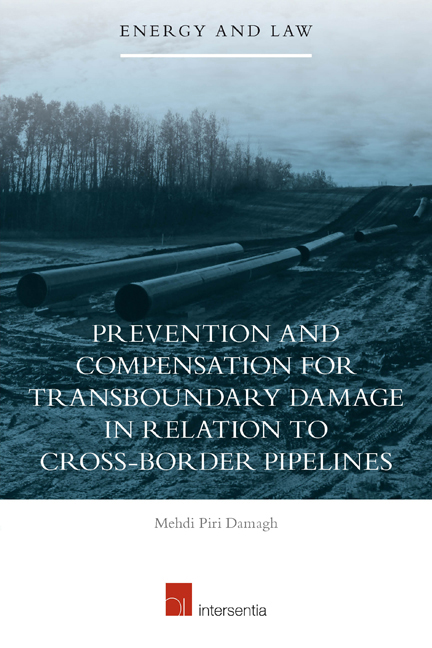Book contents
- Frontmatter
- Dedication
- Acknowledgements
- Contents
- Abbreviations
- List of Tables and Maps
- Chapter 1 Introduction
- PART I INTRODUCTORY ISSUES: PIPELINES, THE NATURE OF RISKS ASSOCIATED WITH PIPELINES AND THEIR REGULATORY REGIMES
- PART II PREVENTION OF CROSS-BORDER PIPELINE ACCIDENTS – MEANS AND SOURCES
- Introductory Note
- Chapter 5 Technical, Safety and Environmental Regulations
- Chapter 6 The Obligations to Prevent Trans-boundary Damage Caused by Crossborder Pipelines
- Chapter 7 An Evaluation of the Safety and Environmental Regulations of Crossborder Pipelines
- PART III STATE RESPONSIBILITY FOR TRANS-BOUNDARY DAMAGE CAUSED BY PIPELINES
- Summary
- Bibliography
- Valorisation Addendum
- Curriculum Vitae
Chapter 7 - An Evaluation of the Safety and Environmental Regulations of Crossborder Pipelines
from PART II - PREVENTION OF CROSS-BORDER PIPELINE ACCIDENTS – MEANS AND SOURCES
Published online by Cambridge University Press: 13 December 2017
- Frontmatter
- Dedication
- Acknowledgements
- Contents
- Abbreviations
- List of Tables and Maps
- Chapter 1 Introduction
- PART I INTRODUCTORY ISSUES: PIPELINES, THE NATURE OF RISKS ASSOCIATED WITH PIPELINES AND THEIR REGULATORY REGIMES
- PART II PREVENTION OF CROSS-BORDER PIPELINE ACCIDENTS – MEANS AND SOURCES
- Introductory Note
- Chapter 5 Technical, Safety and Environmental Regulations
- Chapter 6 The Obligations to Prevent Trans-boundary Damage Caused by Crossborder Pipelines
- Chapter 7 An Evaluation of the Safety and Environmental Regulations of Crossborder Pipelines
- PART III STATE RESPONSIBILITY FOR TRANS-BOUNDARY DAMAGE CAUSED BY PIPELINES
- Summary
- Bibliography
- Valorisation Addendum
- Curriculum Vitae
Summary
INTRODUCTION
As indicated in previous Chapters, cross-border oil and gas pipelines have been hypothesized to pose a range of potential damage. This damage can be classified as trans-boundary damage. Accordingly, given the legal frameworks applicable to cross-border pipelines, in principle a wide range of regulations can be applied to those pipelines. The question arises of how effective those regulations are for the prevention of trans-boundary damage. To answer this question, the current Chapter tries to analyze the effectiveness of these regulations in preventing such damage. In this respect the detailed technical standards will not be examined (also because they are often laid down in agreements between the parties which remain confidential). However, based on the construction of the regulatory framework as sketched in previous Chapters, an argument regarding the effectiveness of this regulatory framework to adequately prevent environmental harm will be provided.
It was mentioned that the legal regime governing cross-border oil and gas pipelines, in particular in relation to the safety and environmental regulations, comprises three different layers. The first layer which is the national legal order can only be discussed by considering the domestic law of the host states. A survey of national laws on these issues is of course beyond the scope of this research. The second layer consists of the commercial agreements between the investor/operator of a pipeline and the relevant host state. There are indeed a wide variety of contract models in relation to oil and gas pipelines. In Chapter 4 it was already noted that cross-border pipelines could be created through the interconnector model contract or via a unified model contract. In the interconnector model, the safety and environmental regulations of pipelines fall under the jurisdiction of the applicable national law. The parties, however, can restrict the application of the domestic law of the host states through contractual clauses. A similar approach can be seen in the unified model. In applying the unified model, safety and environmental standards are mainly chosen by an operator in charge. These regulations, which can be derived from international standards, private standards (trade association standards and self-regulations) or even national standards of other states, should be enforced by the operators in charge.
- Type
- Chapter
- Information
- Prevention and Compensation for Transboundary Damage in Relation to Cross-border Oil and Gas Pipelines , pp. 289 - 310Publisher: IntersentiaPrint publication year: 2015



